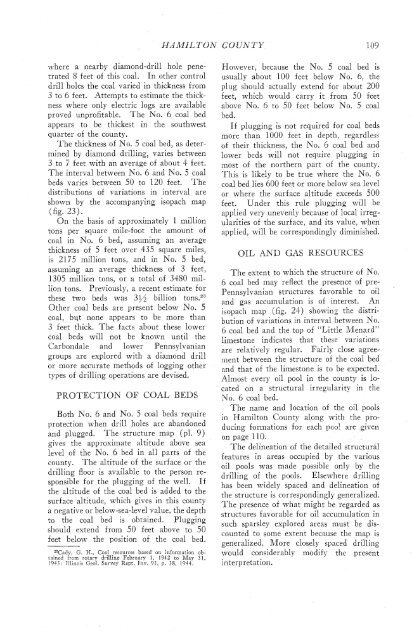subsurface geology and coal resources of the pennsylvanian system ...
subsurface geology and coal resources of the pennsylvanian system ...
subsurface geology and coal resources of the pennsylvanian system ...
Create successful ePaper yourself
Turn your PDF publications into a flip-book with our unique Google optimized e-Paper software.
~vhere a nearby diamond-drill hole penetrated<br />
8 feet <strong>of</strong> this <strong>coal</strong>. In o<strong>the</strong>r control<br />
drill holes <strong>the</strong> <strong>coal</strong> varied in thickness from<br />
3 to 6 feet. Attempts to estimate <strong>the</strong> thickness<br />
where only electric logs are available<br />
proved unpr<strong>of</strong>itable. 'The No. 6 <strong>coal</strong> bed<br />
appears to be thickest in <strong>the</strong> southwest<br />
quarter <strong>of</strong> <strong>the</strong> county.<br />
The thickness <strong>of</strong> No. 5 <strong>coal</strong> bed, as determined<br />
by diamond drilling, varies between<br />
3 to 7 feet with an average <strong>of</strong> about 4 feet.<br />
The interval between No. 6 <strong>and</strong> No. 5 <strong>coal</strong><br />
beds varies between 50 to 120 feet.<br />
The<br />
distributions <strong>of</strong> variations in interval are<br />
shown by <strong>the</strong> accompanying isopach map<br />
(fig. 23).<br />
On <strong>the</strong> basis <strong>of</strong> approximately 1 million<br />
tons per square mile-foot <strong>the</strong> amount <strong>of</strong><br />
<strong>coal</strong> in No. 6 bed, assuming an average<br />
thickness <strong>of</strong> 5 feet over 435 square miles,<br />
is 2175 million tons, <strong>and</strong> in No. 5 bed,<br />
assuming an average thickness <strong>of</strong> 3 feet,<br />
1305 million tons, or a total <strong>of</strong> 3480 million<br />
tons. Previously, a recent estimate for<br />
<strong>the</strong>se two beds was 3s billion tons.23<br />
O<strong>the</strong>r <strong>coal</strong> beds are present below No. 5<br />
<strong>coal</strong>, but none appears to be more than<br />
3 feet thick. The facts about <strong>the</strong>se lower<br />
<strong>coal</strong> beds will not be known until <strong>the</strong><br />
Carbondale <strong>and</strong> lower Pennsylvanian<br />
groups are explored with a diamond drill<br />
or more accurate methods <strong>of</strong> logging o<strong>the</strong>r<br />
types <strong>of</strong> drilling operations are devised.<br />
PROTECTION OF COAL BEDS<br />
Both No. 6 <strong>and</strong> No. 5 <strong>coal</strong> beds require<br />
protection when drill holes are ab<strong>and</strong>oned<br />
<strong>and</strong> plugged. The structure map (~1. 9)<br />
gives <strong>the</strong> approximate altitude above sea<br />
level <strong>of</strong> <strong>the</strong> No. 6 bed in all parts <strong>of</strong> <strong>the</strong><br />
county. The altitude <strong>of</strong> <strong>the</strong> surface or <strong>the</strong><br />
drilling floor is available to <strong>the</strong> person responsible<br />
for <strong>the</strong> plugging <strong>of</strong> <strong>the</strong> well. If<br />
<strong>the</strong> altitude <strong>of</strong> <strong>the</strong> <strong>coal</strong> bed is added to <strong>the</strong><br />
surface altitude, which gives in this county<br />
a negative or below-sea-level value, <strong>the</strong> depth<br />
to <strong>the</strong> <strong>coal</strong> bed is obtained. Plugging<br />
should extend from 50 feet above to 50<br />
feet below <strong>the</strong> positioa <strong>of</strong> <strong>the</strong> <strong>coal</strong> bed.<br />
'3Cady, G. H., Coal <strong>resources</strong> based on information obtained<br />
from rotary drilling February 1, 1942 to May 3 1 ,<br />
1943: Tllinois Geol. Survey Rept. Inv. 93, p. 38, 1944.<br />
However, because <strong>the</strong> No. 5 <strong>coal</strong> bed is<br />
usually about 100 feet below No. 6, <strong>the</strong><br />
plug should actually extend for about 200<br />
feet, which would carry it from 50 feet<br />
above No. 6 to 50 feet below No. 5 <strong>coal</strong><br />
bed.<br />
If plugging is not required for <strong>coal</strong> beds<br />
more than 1000 feet in depth, regardless<br />
<strong>of</strong> <strong>the</strong>ir thickness, <strong>the</strong> No. 6 <strong>coal</strong> bed <strong>and</strong><br />
lower beds will not require plugging in<br />
most <strong>of</strong> <strong>the</strong> nor<strong>the</strong>rn part <strong>of</strong> <strong>the</strong> county.<br />
This is likely to be true where <strong>the</strong> No. 6<br />
<strong>coal</strong> bed lies 600 feet or more below sea level<br />
or where <strong>the</strong> surface altitude exceeds 500<br />
feet. Under this rule plugging will be<br />
applied very unevenly because <strong>of</strong> local irregularities<br />
<strong>of</strong> <strong>the</strong> surface, <strong>and</strong> its value, when<br />
applied, will be correspondingly diminished.<br />
OIL AND GAS RESOURCES<br />
The extent to which <strong>the</strong> structure <strong>of</strong> No.<br />
6 <strong>coal</strong> bed may reflect <strong>the</strong> presence <strong>of</strong> pre-<br />
Pennsylvanian structures favorable to oil<br />
<strong>and</strong> gas accumulation is <strong>of</strong> interest. An<br />
isopach map (fig. 24) showing <strong>the</strong> distribution<br />
<strong>of</strong> variations in interval between No.<br />
6 <strong>coal</strong> bed <strong>and</strong> <strong>the</strong> top <strong>of</strong> "Little Menard"<br />
limestone indicates that <strong>the</strong>se variations<br />
are relatively regular. Fairly close agreernent<br />
between <strong>the</strong> structure <strong>of</strong> <strong>the</strong> <strong>coal</strong> bed<br />
<strong>and</strong> that <strong>of</strong> <strong>the</strong> limestone is to be expected.<br />
Almost every oil pool in <strong>the</strong> county is located<br />
on a structural irregularity in <strong>the</strong><br />
No. 6 <strong>coal</strong> bed.<br />
The name <strong>and</strong> location <strong>of</strong> <strong>the</strong> oil pools<br />
in Hamilton County along with <strong>the</strong> producing<br />
formations for each pool are given<br />
on page 110.<br />
The delineation <strong>of</strong> <strong>the</strong> detailed structural<br />
features in areas occupied by <strong>the</strong> various<br />
oil pools was made possible only by <strong>the</strong><br />
drilling <strong>of</strong> <strong>the</strong> pools. Elsewhere drilling<br />
has been widely spaced <strong>and</strong> delineation <strong>of</strong><br />
<strong>the</strong> structure is correspondingly generalized.<br />
The presence <strong>of</strong> what might be regarded as<br />
structures favorable for oil accumulation in<br />
such sparsley explored areas must be discounted<br />
to some extent because <strong>the</strong> map is<br />
generalized. More closely spaced drilling<br />
would considerably modify <strong>the</strong> present<br />
interpretation.
















